- play_arrow Overview
- play_arrow Understanding Contrail
-
- play_arrow Installing and Upgrading Contrail
- play_arrow Server Requirements and Supported Platforms
- play_arrow Installing Contrail and Provisioning Roles
- Introduction to Containerized Contrail Modules
- Introduction to Contrail Microservices Architecture
- Downloading Installation Software
- Overview of contrail-ansible-deployer used in Contrail Command for Installing Contrail with Microservices Architecture
- Installing Contrail with OpenStack and Kolla Ansible
- Configuring the Control Node with BGP
- Contrail Global Controller
- Role and Resource-Based Access Control
- play_arrow Installation and Configuration Scenarios
- play_arrow Upgrading Contrail Software
- play_arrow Backup and Restore Contrail Software
- play_arrow Contrail Command
- play_arrow Multicloud Contrail
- play_arrow Using Contrail with Red Hat
- play_arrow Using Contrail with Juju Charms
-
- play_arrow Configuring Contrail
- play_arrow Configuring Virtual Networks
- Creating Projects in OpenStack for Configuring Tenants in Contrail
- Creating a Virtual Network with Juniper Networks Contrail
- Creating a Virtual Network with OpenStack Contrail
- Creating an Image for a Project in OpenStack Contrail
- Creating a Floating IP Address Pool
- Using Security Groups with Virtual Machines (Instances)
- Support for IPv6 Networks in Contrail
- Configuring EVPN and VXLAN
- play_arrow Example of Deploying a Multi-Tier Web Application Using Contrail
- play_arrow Configuring Services
- play_arrow Configuring Service Chaining
- play_arrow Examples: Configuring Service Chaining
-
Underlay Overlay Mapping in Contrail
Overview: Underlay Overlay Mapping using Contrail Analytics
Today’s cloud data centers consist of large collections of interconnected servers that provide computing and storage capacity to run a variety of applications. The servers are connected with redundant TOR switches, which in turn, are connected to spine routers. The cloud deployment is typically shared by multiple tenants, each of whom usually needs multiple isolated networks. Multiple isolated networks can be provided by overlay networks that are created by forming tunnels (for example, gre, ip-in-ip, mac-in-mac) over the underlay or physical connectivity.
As data flows in the overlay network, Contrail can provide statistics and visualization of the traffic in the underlay network.
Underlay Overlay Analytics Available in Contrail
Starting with Contrail Release 2.20, you can view a variety of analytics related to underlay and overlay traffic in the Contrail Web user interface. The following are some of the analytics that Contrail provides for statistics and visualization of overlay underlay traffic.
View the topology of the underlay network.
A user interface view of the physical underlay network with a drill down mechanism to show connected servers (contrail computes) and virtual machines on the servers.
View the details of any element in the topology.
You can view details of a pRouter, vRouter, or virtual machine link between two elements. You can also view traffic statistics in a graphical view corresponding to the selected element.
View the underlay path of an overlay flow.
Given an overlay flow, you can get the underlay path used for that flow and map the path in the topology view.
Architecture and Data Collection
Accumulation of the data to map an overlay flow to its underlay path is performed in several steps across Contrail modules.
The following outlines the essential steps:
New Processes/Services for Underlay Overlay Mapping
The contrail-snmp-collector and the contrail-topology are new daemons that are both added
to the contrail-analytics node. The contrail-analytics package contains these new features
and their associated files. The contrail-status displays the new services.
Example: contrail-status
The following is an example of using contrail-status to show the status of the new process and service for underlay overlay
mapping.
user@host:~# contrail-status == Contrail Control == supervisor-control: active contrail-control active … == Contrail Analytics == supervisor-analytics: active … contrail-query-engine active contrail-snmp-collector active contrail-topology active
Example: Service Command
The service command can be
used to start, stop, and restart the new services. See the following
example.
user@host:~# service contrail-snmp-collector status contrail-snmp-collector RUNNING pid 12179, uptime 1 day, 14:59:11
External Interfaces Configuration for Underlay Overlay Mapping
This section outlines the external interface configurations necessary for successful underlay overlay mapping for Contrail analytics.
Physical Topology
The typical physical topology includes:
Servers connected to the ToR switches.
ToR switches connected to spine switches.
Spine switches connected to core switches.
The following is an example of how the topology is depicted in the Contrail WebUI analytics.
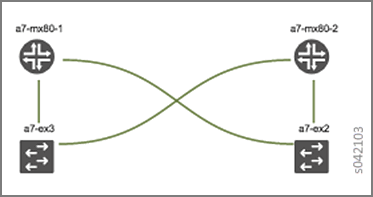
SNMP Configuration
Configure SNMP on the physical devices so that the contrail-snmp-collector can read SNMP data.
The following shows an example SNMP configuration from a Juniper Networks device.
set snmp community public authorization read-only
Link Layer Discovery Protocol (LLDP) Configuration
Configure LLDP on the physical device so that the contrail-snmp-collector can read the neighbor information
of the routers.
The following is an example of LLDP configuration on a Juniper Networks device.
set protocols lldp interface all
set protocols lldp-med interface all
IPFIX and sFlow Configuration
Flow samples are sent to the contrail-collector by the physical devices. Because the contrail-collector supports the sFlow and IPFIX protocols for receiving flow samples,
the physical devices, such as MX Series devices or ToR switches, must
be configured to send samples using one of those protocols.
Example: sFlow Configuration
The following shows a sample sFlow configuration. In the sample, the IP variable <source ip>refers to the loopback or IP that can be reachable of the device that acts as an sflow source, and the other IP variable <collector_IP_data> is the address of the collector device.
root@host> show configuration protocols sflow | display set set protocols sflow polling-interval 0 set protocols sflow sample-rate ingress 10 set protocols sflow source-ip <source ip>4 set protocols sflow collector <collector_IP_data> udp-port 6343 set protocols sflow interfaces ge-0/0/0.0 set protocols sflow interfaces ge-0/0/1.0 set protocols sflow interfaces ge-0/0/2.0 set protocols sflow interfaces ge-0/0/3.0 set protocols sflow interfaces ge-0/0/4.0
Example: IPFIX Configuration
The following is a sample IPFIX configuration from a Juniper Networks device. The IP address variable <ip_sflow collector> represents the sflow collector (control-collector analytics node) and <source ip> represents the source (outgoing) interface on the router/switch device used for sending flow data to the collector. This could also be the lo0 address, if it s reachable from the Contrail cluster.
root@host> show configuration chassis | display set set chassis tfeb slot 0 sampling-instance sample-ins1 set chassis network-services root@host> show configuration chassis tfeb | display set set chassis tfeb slot 0 sampling-instance sample-ins1 root@host > show configuration services flow-monitoring | display set set services flow-monitoring version-ipfix template t1 flow-active-timeout 30 set services flow-monitoring version-ipfix template t1 flow-inactive-timeout 30 set services flow-monitoring version-ipfix template t1 template-refresh-rate packets 10 set services flow-monitoring version-ipfix template t1 ipv4-template root@host > show configuration interfaces | display set | match sampling set interfaces ge-1/0/0 unit 0 family inet sampling input set interfaces ge-1/0/1 unit 0 family inet sampling input root@host> show configuration forwarding-options sampling | display set set forwarding-options sampling instance sample-ins1 input rate 1 set forwarding-options sampling instance sample-ins1 family inet output flow-server <ip_sflow collector> port 4739 set forwarding-options sampling instance sample-ins1 family inet output flow-server <ip_sflow collector> version-ipfix template t1 set forwarding-options sampling instance sample-ins1 family inet output inline-jflow source-address <source ip>
Sending pRouter Information to the SNMP Collector in Contrail
Information about the physical devices must be sent to the SNMP
collector before the full analytics information can be read and displayed.
Typically, the pRouter information is taken from the contrail-config file.
SNMP collector getting pRouter information from contrail-config file
The physical routers are added to the contrail-config by using the Contrail user interface or by using direct API, by
means of provisioning or other scripts. Once the configuration is
in the contrail-config, the contrail-snmp-collector gets the physical router information
from contrail-config. The SNMP collector
uses this list and the other configuration parameters to perform SNMP
queries and to populate pRouter UVEs.
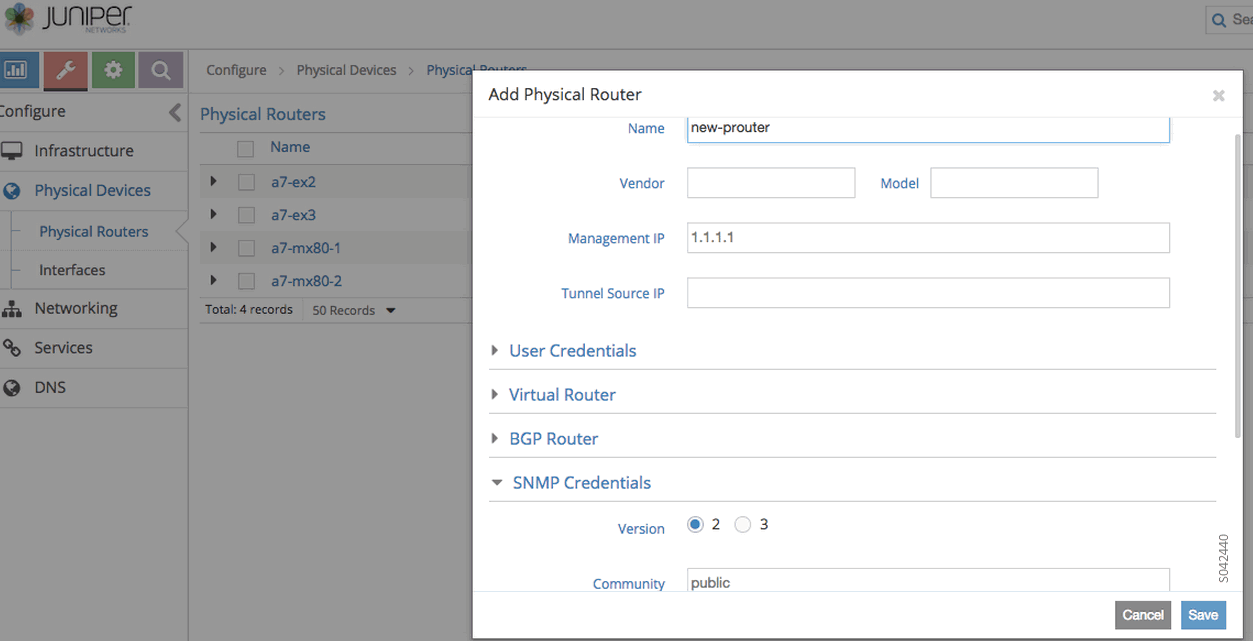
pRouter UVEs
pRouter UVEs are accessed from the REST APIs on your system
from contrail-analytics-api, using a URL
of the form:
http://<host ip>:8081/analytics/uves/prouters
The following is sample output from a pRouter REST API:

Details of a pRouter UVE can be obtained from your system, using a URL of the following form:
http://<host ip>:8081/analytics/uves/prouter/a7-ex3?flat
The following is sample output of a pRouter UVE.
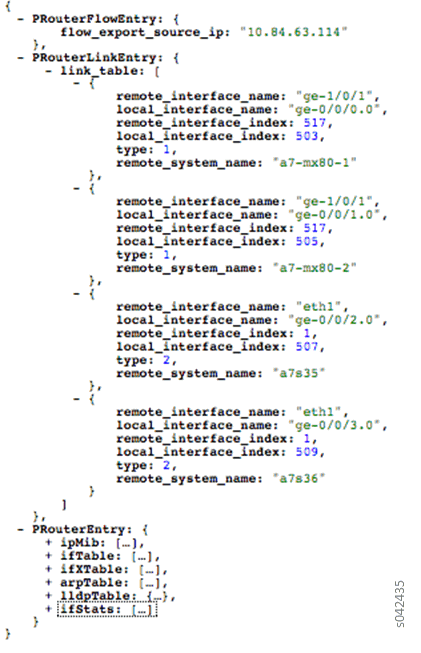
Contrail User Interface for Underlay Overlay Analytics
The topology view and related functionality is accessed from the Contrail Web user interface, Monitor > Physical Topology.
Enabling Physical Topology on the Web UI
To enable the Physical Topology section in the Contrail Web UI:
Viewing Topology to the Virtual Machine Level
In the Contrail user interface, it is possible to drill down through displayed topology to the virtual machine level. The following diagram shows the virtual machines instantiated on a7s36 vRouter and the full physical topology related to each.
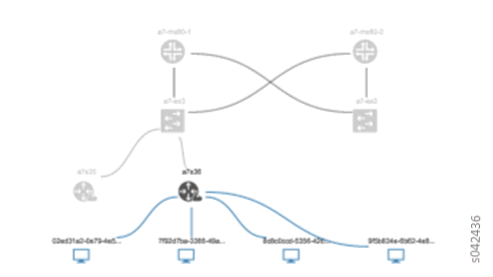
Viewing the Traffic of any Link
At Monitor > Physical Topology, double click any link on the topology to display the traffic statistics graph for that link. The following is an example.
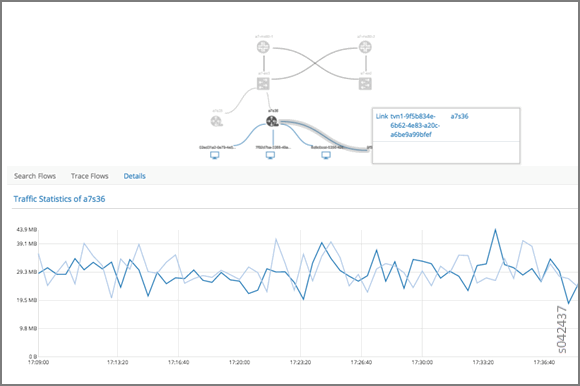
Trace Flows
Click the Trace Flows tab to see a list of active flows. To see the path of a flow, click a flow in the active flows list, then click the Trace Flow button. The path taken in the underlay by the selected flow displays. The following is an example.
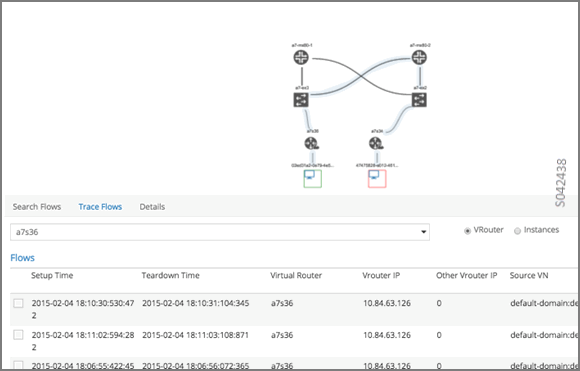
Limitations of Trace Flow Feature
Because the Trace Flow feature uses ip traceroute to determine the path between the two vRouters involved in the flow, it has the same limitations as the ip traceroute, including that Layer 2 routers in the path are not listed, and therefore do not appear in the topology.
Search Flows and Map Flows
Click the Search Flows tab to open a search dialog, then click the Search button to list the flows that match the search criteria. You can select a flow from the list and click Map Flow to display the underlay path taken by the selected flow in the topology. The following is an example.
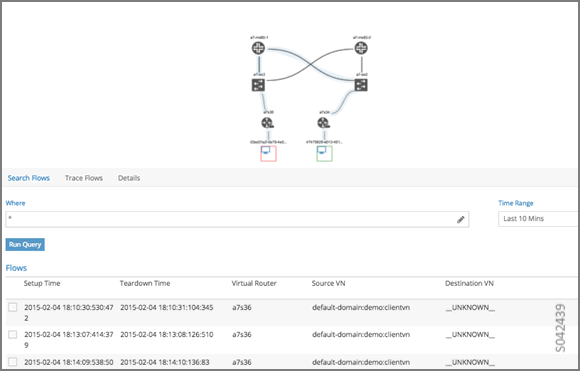
Overlay to Underlay Flow Map Schemas
The schema to query the underlay mapping information for an overlay flow is obtained from a REST API, which can be accessed on your system using a URL of the following form:
http://<host ip>:8081/analytics/table/OverlayToUnderlayFlowMap/schema
Example: Overlay to Underlay Flow Map Schema
{"type": "FLOW",
"columns": [
{"datatype": "string", "index": true, "name": "o_svn", "select": false, "suffixes": ["o_sip"]},
{"datatype": "string", "index": false, "name": "o_sip", "select": false, "suffixes": null},
{"datatype": "string", "index": true, "name": "o_dvn", "select": false, "suffixes": ["o_dip"]},
{"datatype": "string", "index": false, "name": "o_dip", "select": false, "suffixes": null},
{"datatype": "int", "index": false, "name": "o_sport", "select": false, "suffixes": null},
{"datatype": "int", "index": false, "name": "o_dport", "select": false, "suffixes": null},
{"datatype": "int", "index": true, "name": "o_protocol", "select": false, "suffixes": ["o_sport", "o_dport"]},
{"datatype": "string", "index": true, "name": "o_vrouter", "select": false, "suffixes": null},
{"datatype": "string", "index": false, "name": "u_prouter", "select": null, "suffixes": null},
{"datatype": "int", "index": false, "name": "u_pifindex", "select": null, "suffixes": null},
{"datatype": "int", "index": false, "name": "u_vlan", "select": null, "suffixes": null},
{"datatype": "string", "index": false, "name": "u_sip", "select": null, "suffixes": null},
{"datatype": "string", "index": false, "name": "u_dip", "select": null, "suffixes": null},
{"datatype": "int", "index": false, "name": "u_sport", "select": null, "suffixes": null},
{"datatype": "int", "index": false, "name": "u_dport", "select": null, "suffixes": null},
{"datatype": "int", "index": false, "name": "u_protocol", "select": null, "suffixes": null},
{"datatype": "string", "index": false, "name": "u_flowtype", "select": null, "suffixes": null},
{"datatype": "string", "index": false, "name": "u_otherinfo", "select": null, "suffixes": null}]}
The schema for underlay data across pRouters is defined in the Contrail installation at:
http://<host ip>:8081/analytics/table/StatTable.UFlowData.flow/schema
Example: Flow Data Schema for Underlay
{"type": "STAT",
"columns": [
{"datatype": "string", "index": true, "name": "Source", "suffixes": null},
{"datatype": "int", "index": false, "name": "T", "suffixes": null},
{"datatype": "int", "index": false, "name": "CLASS(T)", "suffixes": null},
{"datatype": "int", "index": false, "name": "T=", "suffixes": null},
{"datatype": "int", "index": false, "name": "CLASS(T=)", "suffixes": null},
{"datatype": "uuid", "index": false, "name": "UUID", "suffixes": null},
{"datatype": "int", "index": false, "name": "COUNT(flow)", "suffixes": null},
{"datatype": "string", "index": true, "name": "name", "suffixes": ["flow.pifindex"]},
{"datatype": "int", "index": false, "name": "flow.pifindex", "suffixes": null},
{"datatype": "int", "index": false, "name": "SUM(flow.pifindex)", "suffixes": null},
{"datatype": "int", "index": false, "name": "CLASS(flow.pifindex)", "suffixes": null},
{"datatype": "int", "index": false, "name": "flow.sport", "suffixes": null},
{"datatype": "int", "index": false, "name": "SUM(flow.sport)", "suffixes": null},
{"datatype": "int", "index": false, "name": "CLASS(flow.sport)", "suffixes": null},
{"datatype": "int", "index": false, "name": "flow.dport", "suffixes": null},
{"datatype": "int", "index": false, "name": "SUM(flow.dport)", "suffixes": null},
{"datatype": "int", "index": false, "name": "CLASS(flow.dport)", "suffixes": null},
{"datatype": "int", "index": true, "name": "flow.protocol", "suffixes": ["flow.sport", "flow.dport"]},
{"datatype": "int", "index": false, "name": "SUM(flow.protocol)", "suffixes": null},
{"datatype": "int", "index": false, "name": "CLASS(flow.protocol)", "suffixes": null},
{"datatype": "string", "index": true, "name": "flow.sip", "suffixes": null},
{"datatype": "string", "index": true, "name": "flow.dip", "suffixes": null},
{"datatype": "string", "index": true, "name": "flow.vlan", "suffixes": null},
{"datatype": "string", "index": false, "name": "flow.flowtype", "suffixes": null},
{"datatype": "string", "index": false, "name": "flow.otherinfo", "suffixes": null}]}
Example: Typical Query for Flow Map
The following is a typical query. Internally, the analytics-api performs a query into the FlowRecordTable, then into the StatTable.UFlowData.flow, to return list of (prouter, pifindex) pairs that give the underlay path taken for the given overlay flow.
FROM OverlayToUnderlayFlowMap SELECT prouter, pifindex WHERE o_svn, o_sip, o_dvn, o_dip, o_sport, o_dport, o_protocol = <overlay flow>
SNMP Collector Operation
The Contrail SNMP collector uses a Net-SNMP library to talk to a physical router or any SNMP agent. Upon receiving SNMP packets, the data is translated to the Python dictionary, and corresponding UVE objects are created. The UVE objects are then posted to the SNMP collector.
The SNMP module sleeps for some configurable period, then forks a collector process and waits for the process to complete. The collector process goes through a list of devices to be queried. For each device, it forks a greenlet task (Python coroutine), accumulates SNMP data, writes the summary to a JSON file, and exits. The parent process then reads the JSON file, creates UVEs, sends the UVEs to the collector, then goes to sleep again.
The pRouter UVE sent by the SNMP collector carries only the raw MIB information.
Example: pRouter Entry Carried in pRouter UVE
The definition below shows the pRouterEntry carried in the pRouterUVE. Additionally,
an example LldpTable definition is shown.
The following create a virtual table as defined by:
http://<host ip>:8081/analytics/table/StatTable.UFlowData.flow/schema
struct LldpTable {
1: LldpLocalSystemData lldpLocalSystemData
2: optional list<LldpRemoteSystemsData> lldpRemoteSystemsData
}
struct PRouterEntry {
1: string name (key="ObjectPRouter")
2: optional bool deleted
3: optional LldpTable lldpTable
4: optional list<ArpTable> arpTable
5: optional list<IfTable> ifTable
6: optional list<IfXTable> ifXTable
7: optional list<IfStats> ifStats (tags="name:.ifIndex")
8: optional list<IpMib> ipMib
}
uve sandesh PRouterUVE {
1: PRouterEntry data
}
Topology Module Operation
The topology module reads UVEs posted by the SNMP collector and computes the neighbor table, populating the table with remote system name, local and remote interface names, the remote type (pRouter or vRouter) and local and remote ifindices. The topology module sleeps for a while, reads UVEs, then computes the neighbor table and posts the UVE to the collector.
The pRouter UVE sent by the topology module carries the neighbor list, so the clients can put together all of the pRouter neighbor lists to compute the full topology.
The corresponding pRouter UVE definition is the following.
struct LinkEntry {
1: string remote_system_name
2: string local_interface_name
3: string remote_interface_name
4: RemoteType type
5: i32 local_interface_index
6: i32 remote_interface_index
}
struct PRouterLinkEntry {
1: string name (key="ObjectPRouter")
2: optional bool deleted
3: optional list<LinkEntry> link_table
}
uve sandesh PRouterLinkUVE {
1: PRouterLinkEntry data
}
IPFIX and sFlow Collector Operation
An IPFIX and sFlow collector has been implemented in the Contrail collector. The collector receives the IPFIX and sFlow samples and stores them as statistics samples in the analytics database.
Example: IPFIX sFlow Collector Data
The following definition shows the data stored for the statistics samples and the indices that can be used to perform queries.
struct UFlowSample {
1: u64 pifindex
2: string sip
3: string dip
4: u16 sport
5: u16 dport
6: u16 protocol
7: u16 vlan
8: string flowtype
9: string otherinfo
}
struct UFlowData {
1: string name (key="ObjectPRouterIP")
2: optional bool deleted
3: optional list<UFlowSample> flow (tags="name:.pifindex, .sip, .dip, .protocol:.sport, .protocol:.dport, .vlan")
}
Troubleshooting Underlay Overlay Mapping
This section provides a variety of links where you can research errors that may occur with underlay overlay mapping.
System Logs
Logs for contrail-snmp-collector and contrail-topology are in the following
locations on an installed Contrail system:
/var/log/contrail/contrail-snmp-collector-stdout.log
/var/log/contrail/contrail-topology.log
Introspect Utility
Use URLs of the following forms on your Contrail system to access the introspect utilities for SNMP data and for topology data.
SNMP data introspect
http://<host ip>:5920/Snh_SandeshUVECacheReq?x=PRouterEntryTopology data introspect
http://<host ip>:5921/Snh_SandeshUVECacheReq?x=PRouterLinkEntry
Script to add pRouter Objects
The usual mechanism for adding pRouter objects to contrail-config is through Contrail UI. But you also
have the ability to add these objects using the Contrail vnc-api. To add one pRouter, save the file with the
name cfg-snmp.py, and then execute the
command as shown:
python cfg-snmp.py
Example: Content for cfg-snmp.py
#!python
from vnc_api import vnc_api
from vnc_api.gen.resource_xsd import SNMPCredentials
vnc = vnc_api.VncApi('admin', 'abcde123', 'admin')
apr = vnc_api.gen.resource_client.PhysicalRouter(name='a7-mx80-1')
apr.set_physical_router_management_ip('ip_address')
apr.set_physical_router_dataplane_ip(''ip_address')
apr.set_physical_router_snmp_credentials(SNMPCredentials(version=2, v2_community='public'))
vnc.physical_router_create(apr)
#$ABC123
apr = vnc_api.gen.resource_client.PhysicalRouter(name='a7-mx80-2')
apr.set_physical_router_management_ip('ip_address')
apr.set_physical_router_dataplane_ip('ip_address')
apr.set_physical_router_snmp_credentials(SNMPCredentials(version=2, v2_community='public'))
vnc.physical_router_create(apr)
#$ABC123'
apr = vnc_api.gen.resource_client.PhysicalRouter(name='a7-ex3')
apr.set_physical_router_management_ip('source_ip')
apr.set_physical_router_dataplane_ip('source_ip'')
apr.set_physical_router_snmp_credentials(SNMPCredentials(version=2, v2_community='public'))
vnc.physical_router_create(apr)
#$ABC123'
apr = vnc_api.gen.resource_client.PhysicalRouter(name='a7-ex2')
apr.set_physical_router_management_ip('ip_address')
apr.set_physical_router_dataplane_ip('ip_address')
apr.set_physical_router_snmp_credentials(SNMPCredentials(version=2, v2_community='public'))
vnc.physical_router_create(apr)
#$ABC123'





















